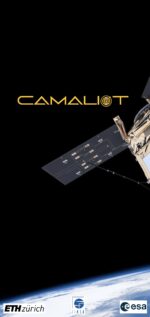 A new app from the European Space Agency (ESA) is enabling members of the public to participate in a global crowdsourced science project by recording small variations in satellite signals using their smartphones, thereby helping to gather data for machine learning analysis of meteorology and space weather patterns.
A new app from the European Space Agency (ESA) is enabling members of the public to participate in a global crowdsourced science project by recording small variations in satellite signals using their smartphones, thereby helping to gather data for machine learning analysis of meteorology and space weather patterns.
The CAMALIOT Android app, developed through ESA’s Navigation Innovation and Support Programme (NAVISP) with the support of the agency’s Global Navigation Satellite System (GNSS) Science Support Centre, asks users with compatible smartphones to leave them by an unobstructed window each night with the satnav positioning turned on so that the app can record small variations in satellite signals.
The CAMALIOT android app is compatible with more than 50 models in the smartphone market that come equipped with dual frequency satnav receivers.
As well as helping to create new Earth and space weather forecasting models, participants are also in with a chance to win prizes including new phones and Amazon vouchers. The four-month ‘citizen science’ campaign runs until the end of July.
Vicente Navarro, navigation engineer, ESA, said, “GNSSs such as Europe’s Galileo have revolutionized everyday life. And the precisely modulated signals continuously generated by the dozens of GNSS satellites in orbit are also proving a valuable resource for science, increasingly employed to study Earth’s atmosphere, oceans and surface environments. Our GNSS Science Support Centre was created to help support this trend.”
For instance, tens of thousands of permanent GNSS stations are continuously recording satnav data. As the satellite signals travel down to Earth they are modified by the amount of water vapor in the lower atmosphere, helping to forecast rainfall, among other weather events.
Satnav signals also undergo delay and fading – known as ‘’scintillation’ – as they pass through irregular plasma patches in the ionosphere. This electrically charged upper atmospheric layer is continuously changing, influenced by solar activity, geomagnetic conditions and the local time of day. Dual frequency satnav receivers can compensate for this effect by comparing their two frequencies.
“The combination of Galileo dual band smartphone receivers and Android’s support for raw GNSS data recording is what opened up the prospect of supplementing data from these fixed GNSS stations with tens of millions of smartphones, vastly increasing our density of coverage,” added Navarro. “We took inspiration from the famous ‘SETI@home’ initiative, where home laptops help seek out signs of extraterrestrial life.”
The results can then undergo a big data, machine learning approach, seeking out previously unseen patterns in both Earth and space weather.
“This is our first step in enlarging GNSS data acquisition using an Internet of Things data fusion approach, employing novel sources such as fixed sensors and drones as well as smartphones. A wide range of other applications are also possible for the system, including improving the performance of GNSS systems,” said Navarro.
Formally known as the ‘Application of Machine Learning Technology for GNSS IoT Data Fusion’ project, CAMALIOT is run by a consortium led by ETH Zurich (ETHZ) in collaboration with the International Institute for Applied Systems Analysis (IIASA).
“The CAMALIOT effort was underpinned by Element 1 of our NAVISP research program, spurring innovation in satellite navigation,” explained Pierluigi Mancini, ESA’s NAVISP program manager.



